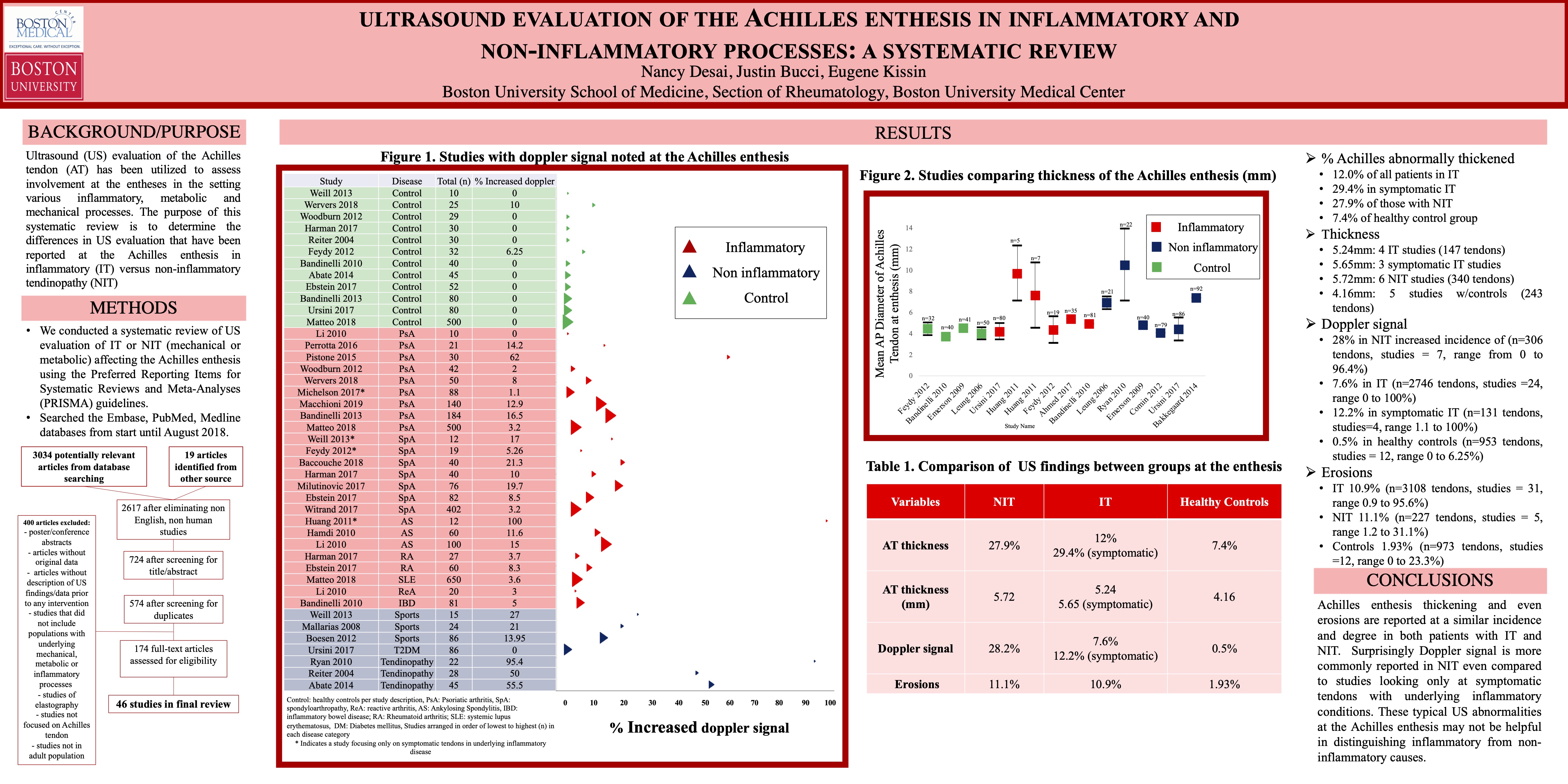Ultrasound Evaluation of Achilles Enthesis in Inflammatory and Non-Inflammatory Processes: A Systematic Review

Nancy Desai, MD
Authors: Nancy Desai MD, Justin Bucci MD and Eugene Kissin MD
Background/purpose:
Ultrasound (US) evaluation of the Achilles tendon has been utilized to assess involvement at the entheses in the setting various inflammatory, metabolic and mechanical processes. The purpose of this systematic review is to determine if US evaluation has been reported to show different findings at the Achilles enthesis with inflammatory (IT) versus non-inflammatory tendinopathy (NIT).
Methods:
We conducted a systematic review of all studies involving US evaluation of IT or NIT (mechanical or metabolic) affecting the Achilles enthesis using the Preferred Reporting Items for Systematic Reviews and Meta-Analyses (PRISMA) guidelines. We systematically searched the Embase, PubMed, Medline databases from start until August 2018. One author applied predefined exclusion criteria, excluding poster or conference abstracts, as well as studies without original data, without description of US findings, studies not focused on the Achilles tendon or studies in children. An additional author was utilized to perform secondary review of these articles and any differences were then mitigated by a 3rdreviewing author. Data was extracted from selected articles assessing tendon thickness, Doppler signal and erosions.
Results:
Our initial search yielded 574 articles, limited to 174 by initial abstract review and to 46 through full text review. Of these, 30 studies investigated an underlying IT, 14 studies focused on NIT, and 2 articles evaluated both. At the enthesis, the Achilles was abnormally thickened in 12.0% of all patients reported in IT and 29.4% in symptomatic IT groups in comparison to 27.9% of those with NIT and 7.4% of those in the healthy control group. The average Achilles enthesis thickness was 5.24mm in 147 tendons in 4 studies of all patients with underlying IT, 5.65mm in patients from 3 studies focused only on symptomatic tendons in those with IT, compared to 5.72mm in 340 tendons from 6 studies including NIT, and 4.16mm in 243 healthy tendons (5 studies) (Figure 1). NIT increased incidence of Doppler signal at the Achilles enthesis to 28.2% (n=306 tendons, studies = 7, range from 0 to 96.4%) in comparison to 7.6% in IT (n=2746 tendons, studies =24, range 0 to 100%), 12.2% in those with specifically symptomatic IT (n=131 tendons, studies=4, range 1.1 to 100%) and 0.5% for healthy controls (n=953 tendons, studies = 12, range 0 to 6.25%) (Figure 2). Incidence of erosions was similar between IT, 10.9% (n=3108 tendons, studies = 31, range 0.9 to 95.6%) and NIT, 11.1% (n=227 tendons, studies = 5, range 1.2 to 31.1%) and 1.93% in healthy controls (n=973 tendons, studies =12, range 0 to 23.3%) (Figure 3).
Conclusion:
Achilles enthesis thickening and even erosions are reported at a similar incidence and degree in both patients with IT and NIT. Surprisingly Doppler signal is more commonly reported in NIT even compared to studies looking only at symptomatic tendons with underlying inflammatory conditions. These typical US abnormalities at the Achilles enthesis may not be helpful in distinguishing inflammatory from non-inflammatory causes.
5 comments
Nancy, important observations!!! Very nicely done! The presentation is very clear!
Dave
Nice to see this Nancy. Best wishes for your future endeavors!
Nice clear presentation. Good job
Interesting work, well done!
nice job on a comprehensive review!